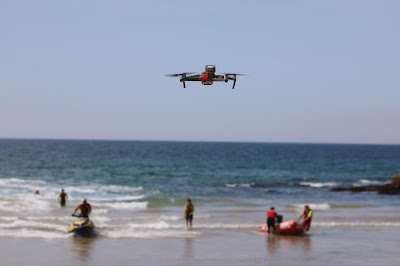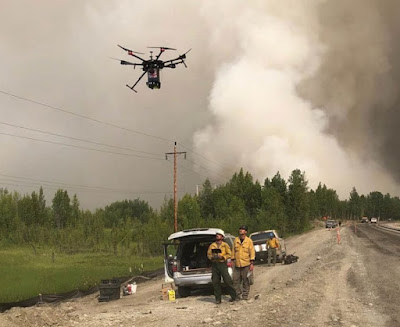While EMMU Aerial specializes in drones for public
safety and emergency response, our initial background came from years supporting emergency
operations with geographical information systems (GIS).
GIS Lounge February 20, 2020
In this article from the GIS Lounge, Brian Sekita discusses how GIS is vital to all phases of the emergency management process.
GIS Lounge February 20, 2020
In this article from the GIS Lounge, Brian Sekita discusses how GIS is vital to all phases of the emergency management process.
Natural disasters such as hurricanes, floods, tornadoes,
earthquakes, and volcanic eruptions have impacted the globe since the beginning
of time. Technological improvements have exponentially improved the global
community’s ability to respond to the challenges presented by unexpected
disasters. Geographic Information Systems (GIS) is a framework for gathering,
managing, and analyzing data. Incorporating GIS into the disaster response
framework has improved planning, response times, collaboration, and
communication during the most challenging dynamic circumstances. Large scale
disasters require extensive amounts of geospatial information regarding regions
affected, infrastructure, and resource requirements. Developments in GIS have
provided agencies with the ability to collaborate more efficiently and
effectively. Emergency managers resolve natural disaster challenges using the
Comprehensive Emergency Management (CEM) approach. CEM is broken down into four
phases: mitigation, preparedness, response, and recovery (Agency, 1995).
Mitigation
Mitigation strategies prior to natural disasters are
essential to reduce loss of life and property by reducing the impact on
populations both within the U.S. and abroad. The Federal Emergency Management
Agency (FEMA), continuously works with local governments, states, and tribes
regarding hazard mitigation plans with short- and long-term focus. These
efforts have the overall intent of increasing education and awareness, building
partnerships for risk reduction, aligning risk reduction objectives, prioritization
of efforts, and to communicate priorities (FEMA, 2020). Flood hazard mapping
updates are part of the Risk Map program. This program identifies flood
hazards, assesses flood risks, and provides accurate data to stakeholders and
partners. These maps are dynamic and can be updated as terrain and
environmental conditions change. FEMA shares this data in publicly accessible
overlays powered by ArcGIS. In addition to flood mapping, overall mitigation
strategies are tracked using the same technology, with 87 percent of the
population currently residing in areas with approved mitigation plans (FEMA,
2020).
Preparedness
Emergency preparedness is the actions taken in advance
that develop operational capabilities, enabling a more efficient, effective
response to an emergency. One successful use of GIS during natural disaster
preparedness is the overland surge from hurricanes also known as the “SLOSH”
model, used by the US National Oceanic and Atmospheric Administration
(NOAA) (NOAA, 2020). SLOSH models use
current wind speed, distance, and direction in combination with precipitation
predictions and topography to determine possible locations at risk of flooding
during a storm. These efforts are critical to evacuation planning, leading to
more effective communication and decision making at all levels. NOAA provides
interactive open source National Storm Surge Hazard Maps for the US, Puerto
Rico / Virgin Islands, Hawaii, and Hispaniola.
The U.S. Army Corps of Engineers (USACE), supports
natural disaster response by providing subject matter experts in areas such as
engineering, biology, hydrology, geology, emergency management, real estate,
contracting, and geographical information systems experts. Together the USACE
staff supports FEMA’s emergency support function # 3 by providing technical
expertise, construction management, and reach back capabilities critical during
time sensitive real-world emergencies. Geographic information systems are a key
component utilized by USACE to communicate real time information in a context
that can be accessed by agencies collaborating to respond to time sensitive
missions. USACES employs GIS to produce sharable digital overlays with
information such as hydrologic and hydraulic models, flood inundation mapping,
consequences models, and data management. GIS development and coordination is
not only executed at the disaster site, but globally using the Modeling,
Mapping and Consequences Production Center (MMC) with SME’s across nine
districts globally (Dalton, 2018). An example of this occurred during Hurricane
Florence, where USAES played a critical role as part of the National Response
Framework (NRF). During this major hurricane, USACE and the MMC utilized the
National Weather Service (NWS) precipitation forecasts to develop flood mapping
to include simulations of operational releases of water from USACE dams and
impacts on levees within the threatened area (Dalton J. C., 2016).
Crowd Sourcing Example
Natural disaster information has traditionally been
obtained from National Mapping Agencies, news organizations, and emergency
agencies operating in the vicinity of the event. As technology continues to
connect the globe, the potential of crowdsourced geographic data has been
viewed as a powerful device to supplement authoritative data, when that data is
unavailable, outdated, or incomplete. During the research project, Evolution of
Emergency Copernicus services (E2mC), designers developed a component termed
“Witness” which enables data acquisition, analysis and storage. Emergency
management has successfully used this application in numerous real-world
emergencies such as the central Italy earthquake and the Haiti Hurricane of
2016 (Havas, 2017).
Recovery
The recovery phase occurs after initial relief has been
provided with the goal of returning property, society, and individual
livelihood back to normalized conditions. Recovery also allows government
organizations and agencies the opportunity to access natural conditions,
updating data and systems to represent geological changes that resulted from
the natural disasters. One such technology that enables a clear concise spatial
representation of the Earth’s surface is LiDAR or Light Detection and Ranging
(National Ocean Service , 2020). LiDAR was used during Hurricane Sandy, one of
the deadliest and most destructive hurricanes of the 2012 Atlantic hurricane
season. NOAA and USGS coordination enabled the collection of high resolution
topographic and bathymetric elevation data. The LiDAR data was utilized to
support studies aimed at hurricane recovery and construction, annotating
changes in the earth’s surface elevations due to storm surge, validate
storm-surge inundation predictions, and ecological assessments. Elevation data
developed by the Disaster Relief Appropriations Act of 2013 were added to the
3DEP and developed into NOAA’s “Digital Coast”, a centralized user friendly
information collection that is cost effective with high accuracy (GIS
Contributor, 2017).
Advancements in technology and the importance of
utilizing geographical information systems to aid in disaster response cannot
be overstated. GIS is vital to all phases of the emergency management process,
leading to a faster, more concise equipped response team. GIS integration into
disaster management enables higher levels of planning, analysis, situational
awareness, and recovery operations. The end state is economic savings,
increased collaboration and a safer population.







